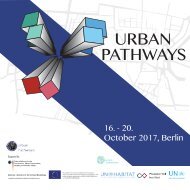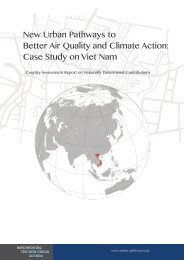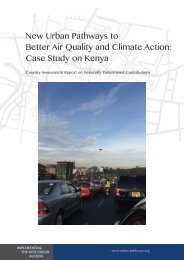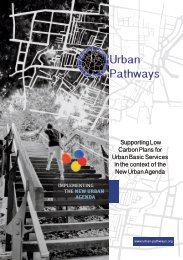Brazil
You also want an ePaper? Increase the reach of your titles
YUMPU automatically turns print PDFs into web optimized ePapers that Google loves.
New Urban Pathways to<br />
Better Air Quality and Climate Action:<br />
Case Study on <strong>Brazil</strong><br />
Country Assessment Report on Nationally Determined Contributions<br />
IMPLEMENTING<br />
THE NEW URBAN<br />
AGENDA<br />
www.urban-pathways.org
Authors/Contributors:<br />
Magdala Arioli, Santhosh Kodukula,<br />
Shritu Shrestha, Stefan Werland<br />
Editor: Oliver Lah<br />
Layout/Design: Barbara Lah<br />
Photo: Copyright © CAIF 2017<br />
Abstract: This paper will help identifying policy measures in line with the<br />
New Urban Agenda and in the context of the Nationally Determined Contribution<br />
for <strong>Brazil</strong>. The paper briefly assesses current and planned mitigation<br />
actions for the urban transport, energy and resource management sectors.<br />
The paper identify relevant stakeholders and institutions focusing on one<br />
specific case study and outlines selected measures currently<br />
under consideration in the city.<br />
<strong>Brazil</strong>´s Nationally<br />
Determined<br />
Contribution target<br />
37% and 43% emission<br />
reduction below 2005 levels<br />
by 2025 and 2030<br />
This project is part of the International Climate Initiative (IKI). The Federal<br />
Ministry for the Environment, Nature Conservation, Building and<br />
Nuclear Safety (BMUB) supports this initiative on the basis of a decision<br />
adopted by the German Bundestag.<br />
IMPLEMENTING<br />
THE NEW URBAN<br />
AGENDA<br />
www.urban-pathways.org
1. Summary of the Nationally Determined<br />
Contribution (NDC)<br />
In its NDC, <strong>Brazil</strong> commits to reduce greenhouse<br />
gas emissions by 37% below 2005<br />
levels by 2025. The NDC also contains a subsequent<br />
indicative contribution to reduce<br />
greenhouse gas emissions by 43% below<br />
2005 levels in 2030. Compared to the 1990<br />
level this translates to 6% respectively 16%<br />
reduction. With this target <strong>Brazil</strong> is the first<br />
major developing country to commit to an<br />
absolute GHG reduction below 1990 levels.<br />
The target, however, will already be achieved<br />
by the success in fighting deforestation over<br />
the past decade. Between 2005 and 2012,<br />
Land-Use, Land Use Change and Forestry<br />
(LULUCF) related emissions were reduced<br />
by over 86% (CAT, 2017, IPCC, 2014). Other<br />
sectors, such as energy, transport and industry<br />
will even be able to increase their emissions<br />
compared to 1990 levels without risking<br />
the achievement of the target (CAT, 2017).<br />
<strong>Brazil</strong>’s NDC corresponds<br />
to an estimated reduction<br />
of 66% in terms of greenhouse<br />
gas emissions per<br />
unit of GDP in 2025 and of<br />
75% in terms of emissions<br />
intensity in 2030, both in<br />
relation to 2005<br />
GHG reduction targets<br />
From a GHG mitigation perspective <strong>Brazil</strong>’s<br />
NDC target represents a very moderate<br />
contribution to global climate mitigation<br />
efforts and falls short of delivering<br />
on the overall goal of the Paris Agreement.<br />
<strong>Brazil</strong>’s per capita emissions would increase<br />
further to an estimated 6.2 tCO2e<br />
by 2025 but then decrease to 5.4 by 2030.<br />
The NDC’s measures and targets give<br />
significant prominence to LULUCF:<br />
• Energy mix: increasing the share of<br />
sustainable biofuels in the <strong>Brazil</strong>ian energy<br />
mix to approximately 18% by 2030.<br />
• Land use change and forests: strengthening<br />
policies and measures to avoid illegal<br />
deforestation and to achieve zero illegal deforestation<br />
in the <strong>Brazil</strong>ian Amazonia by 2030;<br />
compensating for GHG emissions from legal<br />
suppression of deforestation; restoring and<br />
reforesting 12 million hectares of forests<br />
(not excluding exotic species); and enhancing<br />
sustainable forest management practices.<br />
A more ambitious reforestation target<br />
is set in the Native Vegetation Protection<br />
Act, which calls for the recovery of 20 million<br />
hectares of natural vegetation by 2036<br />
(WRI 2015, Obersvatorio do Clima, 2016).<br />
• Energy sector: achieving 45% of<br />
renewables in the energy mix by 2030.<br />
Again this impressive target proofs much<br />
less challenging when compared to today’s<br />
40% renewable share; and achieving<br />
a 10% efficiency increase in the electricity<br />
sector by 2030; sourcing 23 per cent<br />
of power generation from renewable re-<br />
IMPLEMENTING<br />
THE NEW URBAN<br />
AGENDA<br />
www.urban-pathways.org
sources other than hydropower by 2030.<br />
Hydropower currently provides two thirds<br />
of the country’s electricity (WRI 2015).<br />
• Agriculture: strengthening the<br />
Low Carbon Emission Agriculture Program<br />
(ABC) as the main strategy for<br />
sustainable agriculture development.<br />
• Industry: Promote new standards<br />
of clean technology and further<br />
enhance energy efficiency measures<br />
and low carbon infrastructure.<br />
• Transportation: Promote efficiency<br />
measures, and improve infrastructure<br />
for individual transport and<br />
public transportation in urban areas.<br />
Observers such as the <strong>Brazil</strong>ian Obersvatorio<br />
do Clima, the World Resources Institute,<br />
or the NRDC claim that the deforestation<br />
targets are weaker than earlier national targets;<br />
that monitoring needs to be ensured<br />
(despite significant budget cuts to the environmental<br />
ministry); that forest degradation<br />
is increasing again in the most recent years;<br />
and that other sectors besides LULUCF are<br />
not adequately addressed (Observatorio<br />
do Clima, 2016, WRI 2015, NRDC, 2016).<br />
<strong>Brazil</strong>´s Energy Mix:<br />
increasing the share of<br />
sustainable biofuels in the<br />
<strong>Brazil</strong>ian energy mix to approximately<br />
18% in 2030<br />
population of over 2.4 million, with 5.7 million<br />
in the official Metropolitan Area (IBGE,<br />
2014). Car and motorcycle ownership in<br />
Belo Horizonte has increased signifianclty<br />
in recent years as a side effect of growing<br />
welfare levels. Accoridingly, the modal<br />
share in Belo Horizonte suffered significant<br />
changes in the last 17 years: The share of<br />
trips by private motor vehicles increased<br />
from 20,7% to 36,6% while public transport<br />
trips reduced from 44,6% to 28,1%.<br />
2. Sustainable urban basic services initiatives<br />
currently under consideration -<br />
Example of Belo Horizonte<br />
Considering the rather moderate ambition<br />
level of <strong>Brazil</strong>’s NDC, local action<br />
in cities play a crucial role for climate<br />
change mitigation. Belo Horizonte is<br />
one example of an active mid-sized city<br />
commited to sustainable development.<br />
Belo Horizonte is the capital of the state of<br />
Minas Gerais and located in the southeastern<br />
region of <strong>Brazil</strong>. It is the third-largest<br />
metropolitan area in the country and has a<br />
Figure 1: Development of the number<br />
of cars and motorcycles in Belo<br />
Horizonte Source: PlanMob-BH<br />
Table 1: Development of modal share<br />
1995, 2002 and 2012 (number of trips )<br />
1995 2002 2012<br />
Walk 1.122.312 1.072.768 2.200.601<br />
Bicycle 7.661 24.522 26.217<br />
Public Transport 1.295.810 1.678.304 1.775.490<br />
Private car 576.998 940.569 2.062.271<br />
Motorcycle 15.570 33.780 252.983<br />
Other 6.248 17.127 9.381<br />
Total trips 3.024.598 3.767.070 6.326.943<br />
IMPLEMENTING<br />
THE NEW URBAN<br />
AGENDA<br />
www.urban-pathways.org
Local climate action: examples from urban<br />
mobility in Belo Horizonte<br />
As the first city in <strong>Brazil</strong>, Belo Horizonte developed<br />
a Sustainable Urban Mobility Plan,<br />
called PlanMob-BH, in 2013. The plan consists<br />
of elements such as a integrated public<br />
transport network composed of metro<br />
lines and a bus rapid transit (BRT) system<br />
with exclusive bus corridors; a bikeway network<br />
with the installation of protected bike<br />
lanes and a public bicycle sharing system;<br />
and a pedestrian facilities network. The BRT<br />
system was expected to cut travel times<br />
significantly compared to the previous bus<br />
system and to provide a safe and comfortable<br />
inner city transport means (ITDP, 2014).<br />
The goals included in PlanMob-BH are:<br />
• By 2020, the integrated mobility plan<br />
seeks reductions of 27% in GHG emissions,<br />
23% in travel time and 18% in transport costs.<br />
• By 2030, the plan’s final year, the expected<br />
reductions would be 36% in GHG,<br />
25% in travel time and 19% in transport costs.<br />
• The net cumulative GHG emission<br />
savings over the 22-year period<br />
2008-2030 are estimated at 9 MtCO2eq.<br />
Beyond the immediate mobility related issues,<br />
Belo Horizonte also recognises these<br />
measures as opportunity to revitalise the<br />
downtown area and enhancing living quality<br />
by creating pedestrianised streets and<br />
giving the space back to people from cars.<br />
The implementation of PlanMob-BH will<br />
be monitored and evaluated by the Urban<br />
Mobility Observatory which was established<br />
in 2013. The Observatory is composed<br />
of 63 institutions and collects and<br />
aggregates civil society’s demands for<br />
improving mobility, defines performance<br />
indicators and prepares annual reports<br />
on the implementation of PlanMob-BH. In<br />
this process of institutionalizing climate<br />
change policies, Belo Horizonte set the<br />
goal of reducing 20% of GHG emissions<br />
by 2030 considering base year of 2007.<br />
Figure 2: Urban furniture and horizontal<br />
signaling<br />
Figure 3: Horizontal signaling for the Fahrradstraße<br />
IMPLEMENTING<br />
THE NEW URBAN<br />
AGENDA<br />
www.urban-pathways.org
Measures under consideration: lowspeed<br />
zones and cycling streets<br />
As part of the SOLUTIONS project, Belo<br />
Horizonte established a partnership with<br />
Bremen, Germany. From this partnership,<br />
Belo Horizonte will implement a Zone<br />
30 and a bicyle street (Fahrradstraße) .<br />
The main purpose of these measures is to<br />
increase the modal share of bicycle that<br />
currently only represents 0.4%. Belo Horizonte’s<br />
Urban Mobility Plan has the goal to<br />
increase the bicycle trips to 6% by 2020.<br />
This measure will be a pilot-project and is<br />
part PEDALA BH programme. PEDALA<br />
BH aims at promoting the use of bicycles.<br />
Figure 2 illustrates the map of the current<br />
proposals of Zone 30, Fahrradstraßen,<br />
bike lanes and bike paths. Figure 3 is the pilot-project<br />
of Zone 30 and Fahrradstraßen.<br />
Figure 4: Current proposals for cycling network<br />
in Belo Horizonte<br />
Figure 5: Proposal for pilot-project of<br />
Zone 30 and Fahrradstraßen<br />
The Zone 30 pilot-project foresees a wide<br />
deployment of vertical and horizontal signaling,<br />
reallocation and repositioning of<br />
parking spaces to provide the reduction of<br />
the speed, and, enlargement of sidewalks<br />
with the creation of small areas of coexistence<br />
for pedestrians with the insertion of<br />
urban furniture. The Zone 30 pilot project<br />
will be implemented in 2017. Figure 4 and 5<br />
illustrates how the pilot-project will look like.<br />
IMPLEMENTING<br />
THE NEW URBAN<br />
AGENDA<br />
www.urban-pathways.org
3. Conclusion<br />
The NDC submitted by <strong>Brazil</strong> is mostly<br />
based on emission reductions from halting<br />
deforestation which were already achieved<br />
during the last decades. Accordingly, other<br />
sectors such as transport are not affected<br />
by GHG emission reduction efforts. The low<br />
level of ambition on the national level accentuates<br />
the critical role of Brasilian cities to<br />
achieve ambitious GHG emission reductions.<br />
Belo Horizonte has witnessed a dramatic<br />
shift in its modal share with increasing<br />
use of cars at the expense of non-motorised<br />
and public transport modes. In order<br />
to strengthen these forms of mobility, the<br />
city introduced a sustainable urban mobility<br />
plan in 2013 that includes specific targets<br />
for transport related GHG emissions<br />
and the share of low carbon mobility.<br />
Local action in mid-sized<br />
cities can be a vital part of<br />
<strong>Brazil</strong>’s climate change<br />
mitigation efforts<br />
IMPLEMENTING<br />
THE NEW URBAN<br />
AGENDA<br />
www.urban-pathways.org
4. References<br />
Arioli, Magdala / Facchini, Daniela / do Amaral,<br />
Marcelo Cintra (2015) Belo Horizonte, SOLUTIONS<br />
Feasibility studies.<br />
CAT – Climate Action Tracker (2017) <strong>Brazil</strong>. Update:<br />
18th September 2017 Available at: http://climateactiontracker.org/countries/brazil.html<br />
IPCC (2014) Climate Change 2014: Mitigation of<br />
Climate Change. Contribution of Working Group III<br />
to the Fifth Assessment Report of the Intergovernmental<br />
Panel on Climate Change.<br />
ITDP (2014) Belo Horizonte’s First BRT Brings Mobility<br />
and Opportunity. Available at: https://www.itdp.<br />
org/lets-move-belo-horizontes-first-brt-brings-mobility-and-opportunity/<br />
Observatório do Clima (2016) Letter from the Climate<br />
Observatory to ministers Maggi and Sarney.<br />
Available at: http://www.observatoriodoclima.eco.<br />
br/letter-from-the-climate-observatory-to-ministers-maggi-and-sarney/<br />
Prefeitura de Belo Horizonte (2012) PlanMob-BH.<br />
Available at: http://www.bhtrans.pbh.gov.br/portal/<br />
pls/portal/<br />
WRI (2015) A Closer Look at <strong>Brazil</strong>’s New Climate<br />
Plan (INDC). Available at: http://www.wri.org/<br />
blog/2015/09/closer-look-brazils-new-climate-planindc<br />
UN-Habitat is grateful for the financial support<br />
provided by the government of Norway for the<br />
NDC analysis this paper is based on.<br />
www.uemi.net<br />
www.wupperinst.org<br />
www.caif.eu<br />
www.wri.org<br />
IMPLEMENTING<br />
THE NEW URBAN<br />
AGENDA<br />
www.urban-pathways.org








